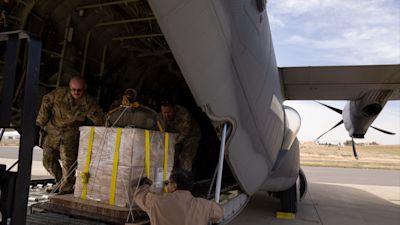Inside a US military plane that is airdropping vital aid into Gaza

As American military pilots closed in on the northern coast of Gaza, journalists aboard the aid mission could hardly spot a single building left untouched by six months of brutal war.
They watched as three tons of humanitarian aid — food, water and hygiene products supplied by Jordan— tumbled out of the rear of the C-130 transport plane, a mess of parachutes trailing behind. It was the 11th American airdrop of aid since the U.S. began the program at the start of March.
“We understand that 6,400 pounds is a drop in the bucket. There are so many people that need aid out there,” Jeremy Anderson, the American lieutenant colonel aboard the aircraft, told the AP reporters who observed the aid delivery Thursday. “We’re doing what we can right now, and opening ground gates or anything outside of air dropping is out of our control.”
The airdrops are part of an international effort to work around extreme difficulties plaguing ground transport of aid into Gaza. Truckloads of aid have been stalled by political and security concerns.
The U.S. also plans to construct a sea bridge, but it will likely be several weeks before it is operational.
Israeli warplanes and ground troops have conducted a scorched-earth campaign on the strip since Hamas’ October 7 attack on southern Israel. The Israeli offensive has killed over 30,000 Palestinians, pushed a quarter of the strip’s population to the brink of starvation, according to UN officials.
The situation is most desperate in the north, where the C-130 crew conducted the airdrops on Thursday.
Up to 300,000 Palestinians are believed to have remained there despite Israeli evacuation orders. Cut off since October, many have resorted to eating animal feed in recent weeks.
Recent airdrops of aid by the U.S. and other countries provide far lower amounts of aid than truck deliveries, which have become rare and sometimes dangerous.
They have been met with some skepticism from UN officials and rights groups, who say that the method is not best practice when it comes to distributing much-needed aid.
Dropping aid from the sky can be dangerous — a recent airdrop killed five people when a package’s parachute failed to engage.
Anderson said the crew’s equipment was built to avoid deaths to recipients.
Have you heard our new podcast Talking Politics? Every week Tom, Robert and Anushka dig into the biggest issues dominating the political agenda…